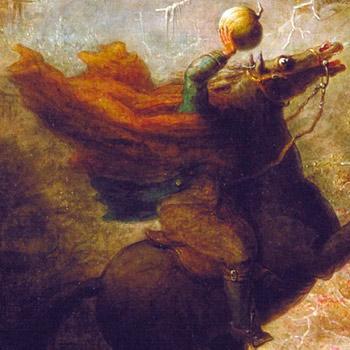External Affairs Chief Jo Ann Gillula recently chatted with Washington Ballet's Artistic Director Septime Webre about the upcoming premiere of The Legend of Sleepy Hollow, opening February 18 at the Kennedy Center. American Art will present the Washington Ballet in excerpts from the new Sleepy Hollow with members of the company, as well as many interactive ballet and art activities on January 31 in the Kogod Courtyard of the American Art Museum.

Detail, John Quidor's The Headless Horseman Pursuing Ichabod Crane
Eye Level: I know you are doing a series of new, commissioned ballets based on great American literature. What drew you to the idea of the Legend of Sleepy Hollow, and what was it about our painting The Headless Horseman that led you to placing it in this early 19th century time period?
Septime Webre: The Legend of Sleepy Hollow is truly America's first great ghost story. It is haunting, poetic, mysterious and supernatural. "The American Experience" initiative is unique to The Washington Ballet and was conceived and launched to transform the American dance aesthetic away from its traditional Eurocentric perspective to one that is rooted in our American stories. The American narrative has not been told in ballet, and my interest is in adapting iconic works of American literature, using our dance vocabulary. Thus far, TWB has world premiered Hemingway: The Sun Also Rises and Fitzgerald's The Great Gatsby, both of which have received such positive acclaim from audience goers and critics alike. We know Sleepy Hollow will be the same.
Former Yale American History professor Bill Lilley came to me knowing that this work would translate quite wonderfully to the ballet stage, as it has a variety of themes such as love, lust, fear, revenge and humor. We worked together with librettist and playwright Karen Zacarias to turn the literary masterpiece into a ballet. The story reflects a time where America was limitless. The unknown was a theme in every American's life. What lies beyond the next mountain? What happens when the dirt road ends? If you take a look at [John] Quidor's The Headless Horseman, you'll notice two things...a boundless mountain scape in the background that represents freedom and beauty, but you'll also notice the trees and bushes looking like skeletal, thorny hands...almost osteoarthritic. Nature is open and endless, but nature can be encapsulating and filled with danger. I want to convey the mood that Quidor does. I want to represent the spectrum of what an unknown frontier conveys; opportunity and danger.
EL: You and your set designer have walked the museum with our curators to discover Hudson River School paintings to use as a basis for your set and costume designs. What were you looking for and how did he decide to use these paintings: as projections or as set pieces that will fly from the stage?
SW: With any great work of art, we were looking to be moved. We were looking for art that triggered our imaginations and engaged us in something bigger than the ideas that we had entered the American Art Museum with. Inspiration comes easily when inside the SAAM. Through the use of projection, images of these works will actually be incorporated in the design of the production. Early political cartoons and satirical drawings from other sources will also be projected as panoramic backdrops. We don't want to give too many secrets away, but just as these paintings captivate a patron to the museum, we will honor these great Hudson River School artists by reexamining and re-celebrating the prominent and bold moods of these works.

John Valentine Haidt's Young Moravian Girl
EL: As soon as you saw the painting Young Moravian Girl, you wanted to use it for the leading ballerina's costume in the role of Katrina. How did that shape your vision of her?
SW: Katrina is coquettish and a bit of a tease. The doe-eyed Young Moravian Girl combines subtlety with a splash of power, and this is something that will translate wonderfully to the ballet stage. With costume design, one has to be cautious of becoming muddy. There are a lot of characters on stage moving and expressing, so the designs must be independent with an underlying unifying theme. The Young Moravian Girl is the same as another member of her church, but like Katrina Van Tassel, she is grabbing and interesting on many levels.
EL: Tell us what style of music composer Matthew Pierce is using for this rural setting? I see his roots are in bluegrass growing up, but he is classically trained and has composed for many ballet companies internationally, including Washington Ballet.
SW: Yes, Matthew has worked with us on other projects, such as ALICE (in wonderland). Pierce imparts a bold and fresh energy to the early 19th century story-based folk music and country fiddling that inspired his score. I think audiences will be thrilled with his nuanced and adventurous sound performed live by a chamber orchestra and youth choir. Many of the choir's vocal lines are written in Gaelic to create a worldly and supernatural mood. One specific poem written by Pierce for this production was inspired by a dullahan, or a headless Gaelic mythical fairy. A line repeats, "Ghearradh tu as mo cheann, is liomsa do cheann," which translates to "You cut off my head, now yours is mine."
EL: Can you tell us the fate of Ichabod Crane or would that be a spoiler?
SW: This may not be Ichabod-specific...but heads will roll.

